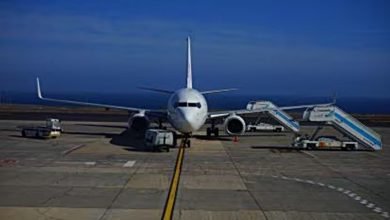No India-China direct flights: Singapore, Vietnam, Bangladesh gain as connecting hubs for flyers | Business News

The evident signs of a thaw in India-China relations has built hopes of normalisation of air connectivity between the world’s two most populous nations, which haven’t had regular passenger flights between them since early 2020. Resumption of direct flights and normalisation of visa issuances—demands China has been making over the past couple of years—are expected to come up in Foreign Secretary Vikram Misri’s discussions with Beijing during his visit, which begins today. Chinese and Indian airlines would be watching keenly.
In September 2024, resumption of direct passenger flights between India and China was discussed in a meeting between India’s Civil Aviation Minister K Rammohan Naidu and Song Zhiyong, the Administrator of the Civil Aviation Administration of China. Earlier in June, Reuters had reported that China was pressing India to resume direct air connectivity between the two countries, while India was resisting it.
In November, resumption of direct flights featured in the discussions between External Affairs Minister S Jaishankar and his Chinese counterpart Wang Yi at their meeting in Rio de Janeiro during the G20 Summit. That meeting took place less than a month after India and China announced a border patrolling arrangement on October 21, a clear sign of de-escalation. Two days later, Prime Minister Narendra Modi and Chinese President Xi Jinping met at the BRICS Summit in Russia.
Lack of direct air connectivity between India and mainland China, along with stringent visa restrictions, have led to airlines from both countries losing out on potential passenger loads. Passenger traffic between the two countries—now solely through connecting hubs in South and Southeast Asia— is now less than half of what it was in 2019. Nevertheless, it is still not insignificant, and a few airlines from other countries have spotted this and capitalised on the opportunity.
 Singapore is now the second-largest connecting hub—after Hong Kong—for India-China passengers, up from the third spot in 2019.
Singapore is now the second-largest connecting hub—after Hong Kong—for India-China passengers, up from the third spot in 2019.
In January-October 2024, the total number of flyers (in both directions) between India and China was over 4.60 lakh, sharply down from close to a million in the corresponding 10 months of 2019, an analysis of passenger data provided by global aviation analytics company Cirium finds. In January-October 2019, direct flight passengers accounted for almost 46 per cent of the total passenger flows between the two countries.
Despite the slump in the overall numbers, airports in Singapore, Vietnam, and even Bangladesh have managed to clock higher India-China passenger traffic than they did in 2019, largely thanks to their respective home airlines’ strategy to focus on connecting such flyers. Other hubs, however, are either yet to catch up, or are struggling.
Singapore, Bangladesh, Vietnam gain
In the first 10 months of 2024, over 98,000 passengers travelling between India and China connected in Singapore, up 16.6 per cent from the corresponding period in 2019. This can be attributed to the Singapore Airlines group offering connections to various points in China from a number of Indian airports via the city-state. Singapore is now the second-largest connecting hub—after Hong Kong—for India-China passengers, up from the third spot in 2019.
Story continues below this ad
Bangladesh’s capital Dhaka, which connected just over 4,500 India-China passengers in the first 10 months of 2019, saw the numbers surge to over 30,000 in the corresponding period of 2024, with Bangladeshi carriers US-Bangla Airlines and Biman Bangladesh capitalising on the opportunity.
Notably, Vietnam’s two major airports—Hanoi and Ho Chi Minh—that had hardly any India-China connecting passengers in 2019, together served as the connecting hubs for nearly 20,000 such flyers in January-October 2024, thanks to Vietnamese carriers VietJet Air and Vietnam Airlines having densified their networks to facilitate transfer traffic via Vietnam.
Where other connecting hubs stand
The Hong Kong airport, which is not exactly considered a Chinese airport due to Hong Kong’s special autonomous status and a different visa regime than mainland China, continues to be the leading connecting hub between India and mainland China. The number of passengers connecting at Hong Kong—almost 1.73 lakh in January-October 2024—was 12.5 per cent lower than the corresponding period of 2019.
Thailand’s capital Bangkok—with its two airports—was the second-largest connecting hub for flyers between India and China in 2019. In January-October 2024, it was at the third spot, connecting nearly 93,000 passengers via the two airports, down around 31 per cent from five years ago. Thai carriers, primarily the Thai AirAsia group, are making efforts to increase their share of this market by adding more capacity on flights to Bangkok from Indian airports.
Story continues below this ad
Kuala Lumpur, too, saw a notable decline in India-China connecting passenger numbers vis-à-vis 2019. Malaysian carriers’ capacities deployed on routes between Kuala Lumpur and both India and China were lower than the pre-pandemic levels. In January-October of 2024, Kuala Lumpur’s India-China connecting traffic was just over 32,000 passengers, down over 44 per cent from the first 10 months of 2019.
Colombo, where over 43,000 passengers travelling between India and China connected in January-October 2019, saw a steep drop of over 82 per cent in the comparable period of 2024. This primarily was on account of aircraft capacity constraints affecting the SriLankan Airlines network. Cirium data shows that SriLankan operated just 290 flights between Colombo and Chinese airports in January-October of last year, sharply down from over 1,200 flights in the same period of 2019.
Opportunity for Chinese and Indian airlines
Although normalisation of air connectivity would likely benefit airlines from both India and China, Beijing likely believes that Chinese carriers have more to gain as they enjoyed the dominant share of the direct flight market between the two countries before the pandemic. It is not surprising then that China has been nudging India to allow reestablishment of direct air connectivity and normalise visa issuances to Chinese nationals.
While China claims that it is issuing a large number of visas to Indian nationals, Indian visa issuances to Chinese nationals have reportedly crashed from around 2 lakh in 2019 to a few thousands in 2024. In January 2024, the Chinese embassy in Delhi had said that over 180,000 Chinese visas were issued to Indian citizens in 2023.
Story continues below this ad
Chinese and Indian airlines had 539 scheduled direct flights a month between the two countries as of December 2019, with a cumulative seat capacity of over 1.25 lakh. Indian carriers—IndiGo and Air India—between them had 168, or around 31 per cent of these flights. The other nearly 70 per cent of the flights belonged to Chinese carriers, which included Air China, China Eastern, China Southern, and Shandong Airlines.
But this does not necessarily mean that Chinese carriers will continue to dominate with such a massive share once direct flight connectivity is re-established, according to aviation industry watchers. Between 2019 and now, a lot has changed in the Indian aviation landscape. Air India is now privatised and well capitalised, and harbours ambitions to grow rapidly, including in the international market. IndiGo, the dominant domestic carrier in India, is a lot more focussed now on expanding its international network.



